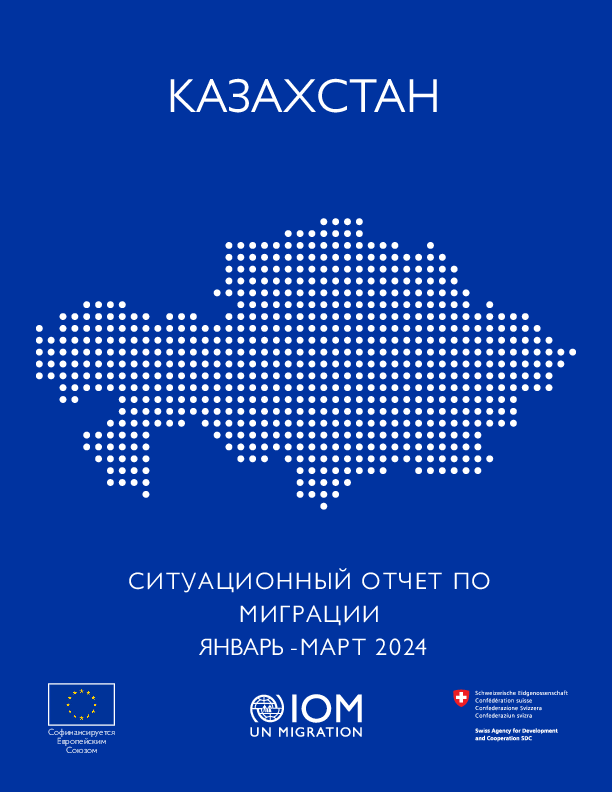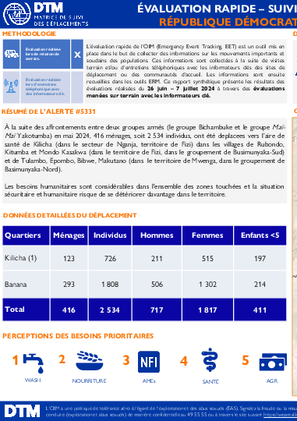-
Countries
-
Data and Analysis
-
Special Focus
-
Crisis Responses

Contact
DTM Chad, dtmtchad@iom.int
Language
English
Location
Chad
Period Covered
Jul 16 2024
Jul 16 2024
Activity
- Mobility Tracking
- Event Tracking
An estimated 823,000 people have crossed into Chad since the onset of the crisis in Sudan, of which 201,379 among them are Chadian returnees. IOM expects this number to rise to 240,000 through to December 2024. This is due to ongoing conflict and food insecurity in Darfur, owing to the current suspension of the humanitarian corridor between Chad and Darfur.

Contact
iomkyrgyzstan@iom.int
Language
English
Location
Kazakhstan
Period Covered
Feb 01 2024
Feb 29 2024
Activity
- Survey
- Return Intention
- Mobility Tracking
- Baseline Assessment
В ходе третьего раунда опроса международных трудящихся-мигрантов, проведенного в семи регионах и трех провинциальных городах, были опрошены 1810 международных трудящихся-мигрантов. Используя метод снежного кома для получения информированного согласия, опрос охватывал демографические данные, социально-экономические характеристики, статус занятости, миграционные намерения, причины миграции, проблемы, с которыми сталкиваются на работе, доходы, денежные переводы, жилье, медицинские услуги, финансовое положение, информацию о правах, местная реинтеграция, влияние санкций и уязвимости. Основные результаты показали, что 32 процента респондентов имеют начальное среднее образование, 50 процентов являются основными кормильцами, 57 процентов не имеют пенсионных выплат, 50 процентов не имеют ежегодного отпуска, 41 процент работают без официальных контрактов и 55 процентов плотят аренду за проживание. Кроме того, 39 процентов заняты в строительном секторе, 70 процентов сталкиваются с высокими расходами на аренду, 26 процентов не имеют медицинских услуг, а 48 процентов переводят более половины своего дохода.

Contact
iomkyrgyzstan@iom.int
Language
English
Location
Kazakhstan
Period Covered
Jan 01 2024
Mar 31 2024
Activity
- Survey
- Return Intention
- Mobility Tracking
- Baseline Assessment
Ежеквартальный отчет был составлен путем объединения вторичных данных, полученных из различных источников, включая государственные органы, международные организации, некоммерческие организации и другие типы организаций. В частности, отчет за первый квартал 2024 года был составлен на основе данных МВД, Бюро национальной статистики и Пограничной службы Республики Казахстана. Данные были собраны на основе сочетания опубликованных источников и прямых запросов к партнерам и государственным учреждениям.

Contact
Angélica Madrigal amadrigal@iom.int
Language
English
Location
Costa Rica
Period Covered
Jun 01 2024
Jul 31 2024
Activity
- Survey
- Registration
- Flow Monitoring
Cantones: Alajuela, Cartago, Corredores, Desamparados, Escazú, Heredia, Los Chiles, San Carlos, San José, Santa Ana y Tibás.
Costa Rica, al igual que otros países de América Central, se ha distinguido por ser un corredor migratorio del flujo en situación de movilidad por las Américas. Este flujo está compuesto principalmente por personas provenientes de la República Bolivariana de Venezuela, Ecuador, Haití, Colombia, así como de otros países de Suramérica, África y Asia. Según estimaciones de la OIM Costa Rica, durante junio de 2024 ingresaron al país aproximadamente 33.022 personas, con un promedio diario de 1.101 personas. Esto representa una disminución del 1% en comparación con mayo de 2024. Además, se identificaron 937 personas varadas en los sitios públicos monitoreados y 981 personas varadas en los albergues monitoreados.

Contact
DTMCostaRica@iom.int
Language
English
Location
Costa Rica
Period Covered
Jun 01 2024
Jun 30 2024
Activity
- Flow Monitoring
- Mobility Tracking
- Event Tracking
Cantons: Alajuela, Cartago, Corredores, Desamparados, Escazú, Heredia, Los Chiles,San Carlos, San José, Santa Ana and Tibás.
Costa Rica, like other Central American countries, has distinguished itself as a migratory corridor for the flow of people in mobility across the Americas. This flow is mainly composed of people from the Bolivarian Republic of Venezuela, Cuba, Haiti, Ecuador, as well as other countries in South America, Africa, and Asia. According to estimates by IOM Costa Rica, approximately 33,022 people entered the country in June 2024, with a daily average of 1,101 people. This represents a 1% decrease compared to May 2024. Additionally, 937 stranded people were identified in monitored public sites and 981 stranded people in monitored shelters.

Contact
DTMCostaRica@iom.int
Language
English
Location
Costa Rica
Period Covered
Jun 01 2024
Jun 30 2024
Activity
- Flow Monitoring
- Mobility Tracking
- Event Tracking
Cantones La Cruz, Upala y Los Chiles
Los movimientos migratorios de personas nicaragüenses hacia Costa Rica son una tendencia constante, intensificándose por factores políticos, económicos y sociales y que representan desafíos continuos para ambos países en la búsqueda de respuestas en materia de políticas migratorias, que incluyan soluciones en empleo, educación, acceso a servicios básicos, entre otros.
Durante junio de 2024, la Dirección General de Migración y Extranjería (DGME) de Costa Rica, registró un total 41.846 movimientos migratorios (53% ingresos y 47% egresos), lo que además representó, con respecto a mayo, un aumento del 18% en ingresos y una disminución del 13% en egresos. Por otro lado, entre el 01 y el 30 de junio, la OIM en Costa Rica registró 15.082 movimientos migratorios en tres puntos fronterizos no oficiales (52 % ingresos y 48 % egresos). Además, se encuestó a 472 personas nicaragüenses (314 en puestos fronterizos oficiales y 158 en cruces fronterizos no oficiales) y 479 acompañantes (352 por puestos fronterizos oficiales y 127 por cruces fronterizos no oficiales).
Entender la dinámica fronteriza de quienes la transitan es fundamental en la comprensión de las necesidades de población migrante y la formulación de propuestas para su atención. Ante estos desafíos, es esencial disponer de información actualizada sobre el perfil sociodemográfico, motivos de migración, necesidades y la dinámica de los movimientos migratorios de persona nicaragüenses en la frontera norte de Costa Rica.

Contact
DTMCostaRica@iom.int
Language
English
Location
Costa Rica
Period Covered
Jun 01 2024
Jun 30 2024
Activity
- Flow Monitoring
- Mobility Tracking
- Event Tracking
Cantons: La Cruz, Upala and Los Chiles
The migratory movements of Nicaraguan nationals to Costa Rica are a constant trend, intensifying due to political, economic and social factors and representing continuous challenges for both countries in the search for answers in terms of migration policies, which include solutions in employment, education, access to basic services, among others.
During June 2024, the Directorate General of Migration (DGME, by its Spanish acronym) of Costa Rica registered a total of 41,846 migratory movements (53% entries and 47% exits), which also represented, compared to May, an 18% increase in entries and a 13% decrease in exits. On the other hand, between June 1st and June 30th, the IOM in Costa Rica registered 15,082 migratory movements at three unofficial border crossing points (52% entries and 48% exits). Additionally, 472 Nicaraguan people were surveyed (314 at official border crossings points and 158 at unofficial border crossings points) and 479 companions (352 at official border crossings points and 127 at unofficial border crossings points).
Understanding the border dynamics of those who transit it is essential in comprehending the needs of the migrant population and formulating proposals for their assistance. In the face of these challenges, it is essential to have updated information on the sociodemographic profile, reasons for migration, needs, and the dynamics of the migratory movements of Nicaraguan people on the northern border of Costa Rica.

Contact
iomtashkent@iom.int
Language
English
Location
Uzbekistan
Period Covered
Jan 01 2024
Mar 31 2024
Activity
- Flow Monitoring Survey
- Mobility Tracking
This report presents the latest available data on recent trends concerning migration issues in Uzbekistan, drawing upon data available for January-March 2024 and providing relevant comparisons on migration trends based on information from national and international datasets that are available to the public. The report includes recent major global and regional events that are significantly impacting the migration situation in the country. The ongoing Russian invasion of Ukraine has impacted traditional migration corridors in the region since 2022. Furthermore, the impact of the changing labour migration flows, the increase of migration related to climate change, the growing urbanization process, the social-economic circumstances, increased irregular migration trends and other major events are also described as main contributing factors of the human mobility and migratory movements in the given period in the country.

Contact
iomastana@iom.int iomalmaty@iom.int
Language
English
Location
Kazakhstan
Period Covered
Jan 01 2024
Jan 31 2024
Activity
- Mobility Tracking
- Baseline Assessment
Базовая оценка мобильности была проведена в 10 областях, включая 3 города Республиканского значения - г. Шымкент, г. Алматы, г. Астана, а также 1245 сёл, в период с декабря 2023г. по январь 2024г. Во время оценки, было проинтервьюировано 2303 ключевых информаторов. По оценкам ключевых информаторов, 639 799 международных трудящихся мигрантов проживали в исследуемых локациях с 2020г. по 2023г.. Также, было выявлено 41 574 внутренних мигрантов в 10 областях, а 10 544 граждан Казахстана проживали за границей в качестве эмигрантов. К тому же, было выявлено 6005 возвратных мигрантов в исследуемых областях.

Contact
DTM Support — iomdrcdtm@iom.int
Language
French
Location
Democratic Republic of the Congo
Period Covered
Jul 01 2024
Jul 07 2024
Activity
- Mobility Tracking
- Event Tracking
L’évaluation rapide de l’OIM (Emergency Event Tracking, EET) est un outil mis en place dans le but de collecter des informations sur les mouvements importants et soudains des populations. Ces informations sont collectées à la suite de visites terrain et/ou d’entretiens téléphoniques avec les informateurs clés des sites de déplacement ou des communautés d’accueil. Les informations sont ensuite recueillies dans les outils ERM. Ce rapport synthétique présente les résultats des évaluations réalisées du 1 – 7 juillet 2024 à travers des évaluations menées sur terrain avec les informateurs clé.
A partir du 25 mai 2024, des affrontements ont été signalés dans les hauts plateaux du territoire de Fizi entre deux groupes armés : le groupe CNPCS (Babembe) et le groupe Maï-Maï Bishambuke (Bafuliru). Ce conflit a occasionné un déplacement significatif de la population du territoire de Fizi (dans les secteurs de Ngandja et Mutambala des groupements Kitongo, Basikalangwa et Basimunyaka-Sud) dans les villages de Bijombo, Babengwa, Kalingi, Rugezi, Bishaka, Bibokoboko, Na-aso, Mulunguamabwe, Mamba-matangi, Titili, Kitumba, Kabanja, Lulenge et Masike vers les villages de Basimweya/Lumbwe (1), Basilubanda/Lumbwe (2), Basilubanda/Namukala (du groupements Basikalangwa et Luchimu du groupement Basikasilu dans le secteur de Ngandja) du territoire de Fizi dans la province du Sud-Kivu. La majorité de ces personnes déplacées sont hébergées dans les familles d’accueil et peu d’eux a reçu une assistance humanitaire.
